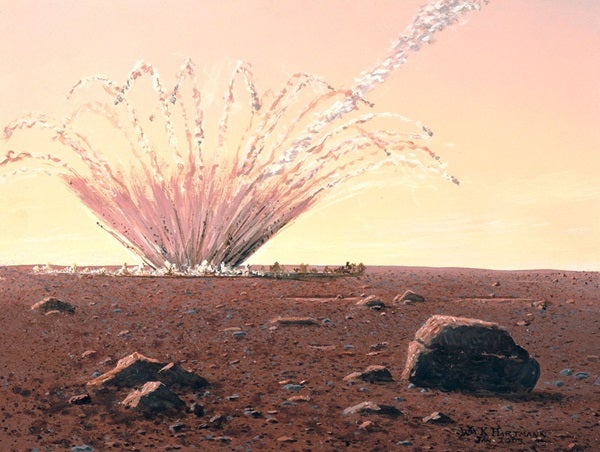William K. Hartmann has been named the 2010 winner of the Meteoritical Society’s Barringer Medal and Award, which recognizes outstanding work in the field of impact cratering.
Hartmann, co-founder of the Tucson-based Planetary Science Institute (PSI), is an internationally recognized expert on impact cratering and the evolution of planetary surfaces. Among his many contributions to the field, the Meteoritical Society is honoring his discovery of the Moon’s giant Orientale impact basin, a discovery he made as a graduate student in 1962 under the direction of space sciences pioneer Gerard Kuiper.
The society also is recognizing his development of a system of “isochrons,” which uses the number of impact craters on various martian geological formations to estimate their age. Hartmann has developed and refined the system during several decades of research at the PSI. As early as 1965, he used the method to correctly predict the age of lunar lava plains to be about 3.5 billion years old. This age was later confirmed by studies of lunar material returned to Earth by Apollo astronauts.
Although Hartmann has applied the isochron system mainly to the Moon and Mars, his long-term goal is to apply the concept to planets and satellites throughout the solar system.
Hartmann will officially receive the medal and award next summer at the society’s annual meeting, which will be held in New York City in 2010.
In addition to his career as a planetary scientist, Hartmann also is internationally recognized as both a writer and artist. He has published several books in the area of popular science, as well as two novels. He is on the editorial advisory board of Astronomy magazine, and has written a number of articles for them, including “Origin of the Solar System,” “State of Mars,” “Mars Update,” et al. Many of his space-science-related paintings have been published in scientific and science-fiction books and magazines.
The Barringer Medal and Award, which is sponsored by the Barringer Crater Co., was established in 1982 to honor D. Moreau Barringer Sr. and his son D. Moreau Barringer Jr. Around 1906, the senior Barringer was the first to seriously propose an impact origin for the Arizona crater that now bears his name. It took several decades for him to convince geologists that this was correct, and asteroid impacts are now recognized as a key process in the Earth’s geologic history and in the evolution of its plants and animals.
“The Barringer family has a long history of stewardship with Meteor Crater in Arizona, and currently operates the museum there,” Hartmann noted. “They work with scientists to support research on the crater and on related impact-crater phenomena on the planets. They are highly regarded in the scientific community, and have been strong supporters of planetary science.”
“It’s an honor to receive this award because it’s associated with both the Meteoritical Society and the Barringer Crater, and also because it emphasizes the growing awareness that impacts have helped shape the Earth as we know it,” Hartmann said.










